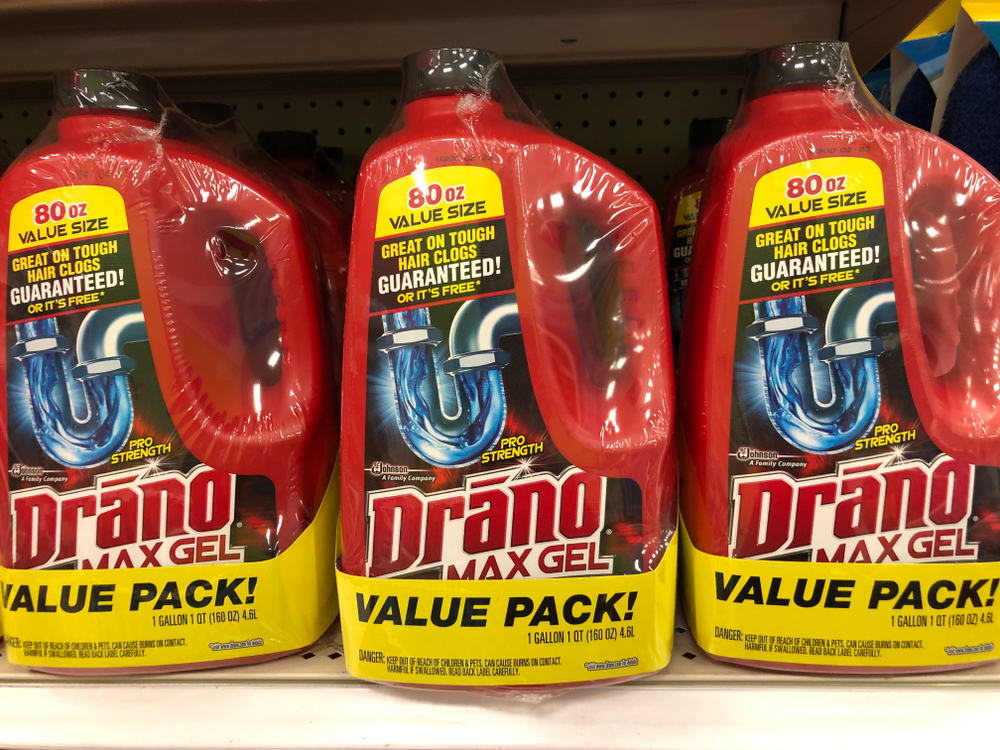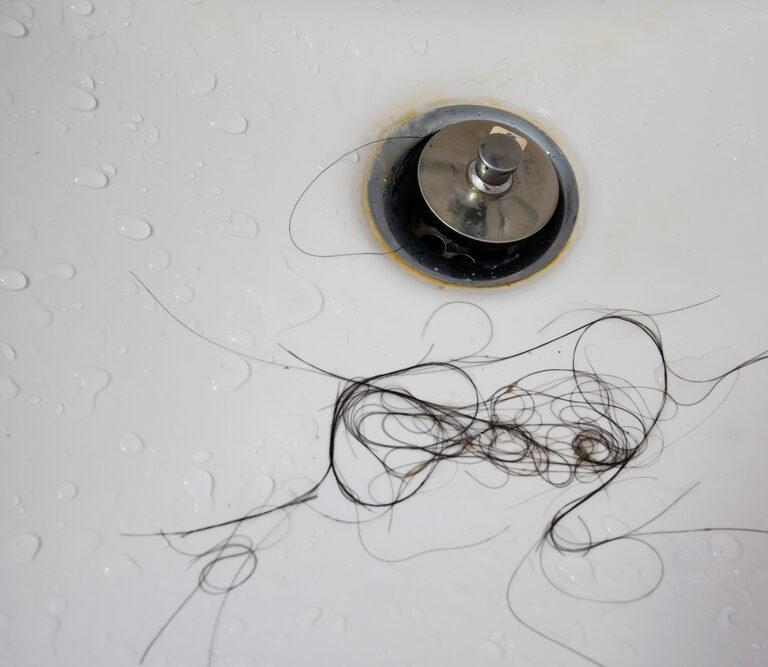With hair, soap, and grime going down your shower drain regularly, it’s only a matter of time before your shower ends up with a clog. If you find that your shower drains slower than normal – or not at all – then it’s time to bust the clog stuffing up your pipes.
If you aren’t sure how to unclog a shower drain, then read on. We’ll cover each effective method for avoiding a visit from the plumber.
Busting Clogs Au Naturel
If you notice your shower is draining slowly, you’ll want to nip it in the bud immediately. There are a couple of simple things around your house that can help you bust up a clog. Best of all – they’re cheap, non-toxic, and natural.
Boiling Water
One of the quickest and easiest methods for clearing a clogged shower drain is by using extreme heat. Boiling water can help melt soap and grease, which can bind with hair to cause a clog. Heat a pot of water on the stove, and pour it in. Simple.
Just keep in mind, this isn’t an ideal solution if you have PVC pipes. PVC is not very heat-resistant naturally, and it may have a melting point as low as 212 degrees Fahrenheit, depending on the additives the manufacturer used when creating the pipes.
If your pipes are PVC, just keep the water below the boiling point to prevent damage.
Baking Soda and Vinegar
When in doubt, break the baking soda and vinegar out. The combination of baking soda and vinegar causes a fizzy reaction that may help loosen the clog.
Start by putting a cup of baking soda into the drain. Next, slowly pour in a cup of vinegar, and enjoy watching your homemade bathroom volcano. Let it sit for at least 30 minutes to allow the fizz to work, and chase it with hot water.
Channeling Your Inner Plumber
If natural quick-fixes won’t cut it, you might need to utilize mechanical intervention to free the clog. With the right tools and a bit of elbow grease, you should be able to clear any shower drain clog yourself.
Go Fishing for the Clog
If you want to avoid sending the clog further into your pipe, where it can create a bigger problem, then you’ll want to pull the clog out. The most common types of clogs in showers are those caused by hair, so getting hold of it shouldn’t be too hard.
To fish a clog out, you may need some tools. A pair of needle nose pliers, a drain zipper, or a wire coat hanger can all work, depending on how accessible the clog is.
Remove the drain stopper if you can. If you have a drain stopper you can’t easily remove, you can try to maneuver the tool around the stopper. Once you’ve got a hold on the clog, pull it out and prepare for a gross surprise.
Use a Plumbing Snake
If you’ve got a clog in your drain that’s out of the reach of a drain zipper or coat hanger, then you might have to use a plumbing snake. They come in different form factors and sizes, but most likely, you’ll want a 1/4-inch drain snake.
- Since the tip of the snake is fatter than the rest of the cable, you may need to remove the drain cover. If you can’t remove it, then you’ll need to go through the overflow pipe if you have one.
- Operating a handheld snake is easy enough. While holding the snake with one hand, use the other hand to feed the snake into the pipe. If you hit a snag, you’re probably at a sharp bend.
- Leave 6 to 8 inches of the snake exposed between the drain hole and the tip of the drum. Tighten the thumbscrew and twist the snake while pushing forward. Once you’ve made it further into the pipe, loosen the thumbscrew and continue feeding it through the pipe.
- If you can’t keep feeding it through any further, you’re probably stuck on the clog. Tighten the thumbscrew and twist the snake clockwise to hook onto it. Once you feel you’ve grabbed the clog, loosen the thumbscrew again and reel the snake back in.
- While pulling it back in, don’t panic if you hit a snag. If you pull on the snake too hard while it’s caught on something, you can damage, or even break it off in your pipe. Instead, apply consistent force and continue to turn the snake to help it over any snags.
Conquering Clogs With a Plunger
You might think plungers are only for toilets, but that couldn’t be further from the truth. In fact, cup plungers (the kind that probably comes to mind when you think of plungers) are specifically designed for flat surfaces like sink and shower drains.
When plunging a drain, you’ll want to have enough water in the floor of your shower to allow the plunger to seal to the floor. Once you have a good seal, use the plunger to push and pull water through the drain.
You’ll want to focus on pulling as much as pushing. A good pull can either pull the clog up, or put more water in the plunger, allowing for greater pushing force.
If you notice the plunger suddenly becomes easier to work, you may have freed the clog. See if the drain works properly – if not, try again or move on with another method.
Tips for Effective Plunging
Plunging is simple, but in order to clear your clog, you need to create a good seal. Cup plungers are made specifically to create a seal on flat surfaces, but if you’ve only got a flange plunger handy, there’s no need to worry.
Simply warm the plunger up with hot water to make it pliable, and fold the flange inward. This will create a flat surface that will suction to the shower floor as well as a cup plunger.
Speaking of sealing, if you’re having trouble getting the plunger to seal, try warming it up or adding a ring of petroleum jelly around the lip to get a better seal. You may also need to plug your overflow pipe, if your shower has one, in order to create the proper suction to move the clog.

Suck It up With a Shop Vac
If you’ve got a super stubborn clog, and you happen to have a shop vac available, you’re in luck!
A shop vac, also known as a wet-dry vacuum, is a high-powered vacuum that works great on stubborn clogs in any drain in your home. Using a shop vac will take most of the time and laborious effort out of clearing a clog, but it’s also the most expensive option.
First, check to make sure your shop vac hose fits over the drain opening. If it doesn’t, you’ll need a towel or rag around the hose to create a seal. You may also need to close off the overflow pipe if you have one, depending on where the clog is.
To close off the overflow pipe, simply stuff a rag wrapped in a plastic bag into the overflow pipe. This will help create more suction to help pull the clog free.
Chemical Drain Cleaners – The Last Resort
As many bathroom clogs consist of organic materials like soap and hair, you might find that commercial drain cleaners work effectively on clogs. Products like Drano can work effectively to dissolve clogs enough to push them through your pipes.
However, you should be wary about using chemical drain cleaners for a couple of reasons.
Drain Cleaners Are Extremely Harmful
As you may have guessed, harsh chemicals can have serious consequences for your health. By using chemical drain cleaners, not only are you at risk for chemical burns from stray splashes, but you also put yourself at risk of exposure to the noxious vapors they can emit.
While you can take steps to reduce these risks, it’s better to shy away from using them altogether if possible. If you must use them, then make sure to exercise extreme caution and provide proper ventilation to avoid inhaling toxic fumes.
WARNING!
If you’ve recently used other chemicals to clear the clog, such as baking soda and vinegar, flush your shower and pipes thoroughly with water before using any drain cleaner. Since drain cleaners contain chemicals like bleach, you may accidentally create toxic gas that could fatally endanger you and your entire family.
Drain Cleaners Can Damage Your Plumbing
Drain cleaners are corrosive and create a lot of heat. But unless they manage to bust the clog fairly quickly, then the solution will sit behind the clog in your pipes. For PVC pipes, the heat may partially melt the pipes, while the chemicals may corrode and weaken metal pipes.
While these dangers are relatively rare, excessive or improper use of drain cleaners can increase your chances of further issues. And if you think paying a plumber to simply unclog your drain is expensive, you’re in for a real treat when you learn how much replacing your pipes could cost.
Take Measures to Prevent Future Clogs
You can resolve clogs easily enough yourself. But preventing them from occurring is the best method for dealing with clogs. There are a couple of ways you can keep them from coming back.
Shower Drain Covers
You may be able to find aftermarket drain covers for your shower to prevent hair and chunks of soap from getting into your drain. Something like the Tub Shroom works well for bathtub showers, while a shower stall drain protector can work great for shower stalls.
Enzyme Drain Cleaners
While drain covers work wonders for keeping hair and other solids out your drain, they won’t stop general buildup in your pipes. One way to keep buildup from becoming a problem is by using an enzyme-based drain cleaner.
These bacteria-based cleaners use microorganisms to eat away at organic buildup in pipes, keeping your drains from clogging. Cleaners like this one work great for routine maintenance, and they’ll help ensure your pipes stay as clean and clear as a drain pipe can be.
Let It Wash Away
Dealing with a shower clog can be stressful and expensive. But you don’t need to be a plumber to deal with a simple clog. With the right knowledge, proper tools, and a bit of persistence, you can get your shower running like new without having a plumber step foot in your house.
Dealing with a shower clog can be stressful and expensive. But you don’t need to be a plumber to deal with a simple clog. With the right knowledge, proper tools, and a bit of persistence, you can get your shower running like new without having a plumber step foot in your house.
